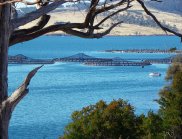Researchers develop environmental assessment model for southern Tasmanian estuaries
The A$1.5 million project will focus on estuarine and marine environments of the Derwent and Huon Rivers and around Bruny Island, particularly the management of salmon farms, a local industry currently valued at A$300 million.
CSIRO’s Wealth from Oceans Flagship marine scientist, Dr Scott Condie, said the computer-based tool will be a type of simulator, which allows management ideas to be tested, before being implemented in reality.
“The project will help industry, regulators and local communities to better understand how changes in the concentration of fish pens, the expansion of other industries, or new housing developments, will impact their marine and estuarine environments.”
Dr Scott Condie, CSIRO Wealth from Oceans Flagship
“The project will help industry, regulators and local communities to better understand how changes in the concentration of fish pens, the expansion of other industries, or new housing developments, will impact their marine and estuarine environments,” Dr Condie said.
Dr Catriona MacLeod of the University of Tasmania’s Institute for Marine and Antarctic Studies said the first stage of the research will be engaging with key stakeholder groups.
“We want to identify the regionally relevant environmental values, particularly with respect to their relationship to marine farming and how they relate to farm management practices and monitoring of the marine environment to tackle problems such as toxic algal blooms,” said Dr MacLeod.
Scientists have identified this region as a microcosm of the issues facing coastal development and management throughout Australia. The region includes:
- a metropolitan city, Hobart
- significant coastal industries such as metal refining and paper production, commercial and recreational fisheries (flathead, lobster, abalone)
- major aquaculture production (salmon, oysters), and
- increasing development of catchments for intensive irrigated agriculture (grapes, cherries).
The region has also been identified by scientists as a climate change hotspot, where there are indications of a significant shift in water temperatures and nutrient levels.
“The project will develop a computer model that can be adapted for coastal communities around Australia, to assist them with issues like, how to proceed with urban development, through to addressing any effects of climate change,” Dr Condie said.
The integration of community values with environmental understanding via computer modelling, will help government agencies better manage risks facing coastal marine environment and communities.
The research findings will be published during the project, with a final report due in 2016.
The four year project, a collaboration between CSIRO’s Wealth from Oceans Flagship and the University of Tasmania’s Institute for Marine and Antarctic Studies (IMAS), is funded by the Fisheries Research and Development Corporation (FRDC).
Media resources
Click image for high resolution version

